
The influence of the ‘Alien’ film series simply cannot be overstated in the field of video games, specifically first person shooters; even to the point where a handful of guys from Shreveport, Louisiana, with their small development team known as iD Software churned out the genre-defining DOOM. Originally planned to be a title licensed to the ‘Alien’ franchise, these negotiations were scrapped at the last minute as iD Software felt they would have more creative freedom over the design and direction of their game. The impact DOOM made can simply never be overstated, from defining the FPS genre, to showcasing the PC as a viable gaming platform.
Since the inception and birth of the FPS, the gaming public at large has been treated to a variety of interpretations and expansions of the experience as gaming technology accelerated onwards and upwards. By the year 1999, after a string of average arcade and console interpretations of Alien, we were finally treated to the definitive experience of Aliens Vs Predator (1999, Rebellion), pitting the three species (Alien, Predator and Marine) against each other in a bloody struggle for survival in their respective campaigns. However, despite the wildly successful and eerie sequel, Aliens Vs Predator 2 (2001, Monolith Productions), and the subsequent, sub-par experiences of Aliens Vs Predator (2010, Rebellion) and the widely panned Aliens: Colonial Marines (2013, Gearbox Software), the series lacked a genuine, grass-roots experience of the original frightening phenomenon of the first 1979 film, Alien.
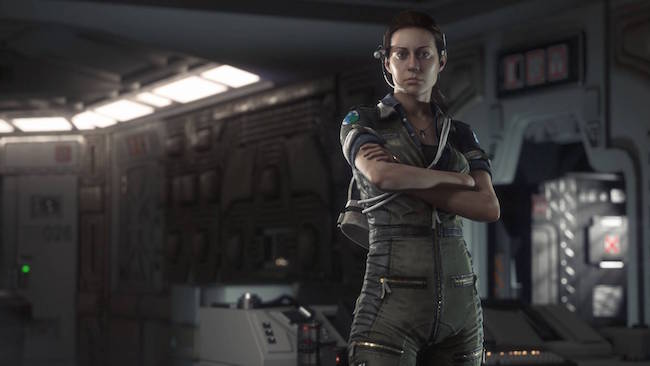
It’s worth noting at this point that every subsequent experience of extra-terrestrial terror mostly thematically drew from the same source material (Alien, 1986) as the very first DOOM game 20 years beforehand, while most had essentially disregarded the cult Ridley Scott masterpiece as a factor of influence. Until now…
With the recent reinvigoration of the “survival horror” genre, with stellar titles like Amnesia: The Dark Descent (2010, Frictional Games), and Outlast (2013, Red Barrels), a new bar has been raised in what constitutes a genuinely frightening experience of slow-burning ambient dread. It was only a matter of time until someone, somewhere heard that ominous bleep on their radar, and honed in on the horrific form of one of science fiction’s most iconic pieces of nightmare fuel: the Xenomorph. Welcome to Alien Isolation; likely to be one of the most defining experiences of the Alien franchise to date, and for some time, has finally brought home the slow-burning horror of the Ridley Scott masterpiece set in the original vision of 1970’s tech-noir, with all the modern benefits of current gaming technology, as well as making full use of modern design and horror standards. Does it work? You bet your terrified ass, it does.
The team at The Creative Assembly took special care to ensure that the narrative of Alien Isolation remained cohesive to the established canon of the Alien film series; set fifteen years after the events of Alien (1979), Alien Isolation follows the story of Ellen Ripley’s daughter, Amanda Ripley, now an engineer for Weyland-Yutani who elected to undertake a specific mission since it involved recovering the flight recorder from her mother’s ill-fated journey in the USCSS Nostromo. From the outset of Alien: Isolation, we learn that the flight recorder has recently been recovered by a salvage team, and is being held at Sevastopol station, the main setting for the game. Sevastopol itself is a large, sprawling, fully-integrated space station, complete with retail and recreational facilities, a transit system and various maintenance and engineering facilities. However, in the last few years, the station has fallen into significant disrepair, as it has been slated for decommissioning. This proves to be a solid choice of setting, as it has given the writers enough freedom to expand into this unexplored realm of storytelling while still remaining true to the established Alien canon.
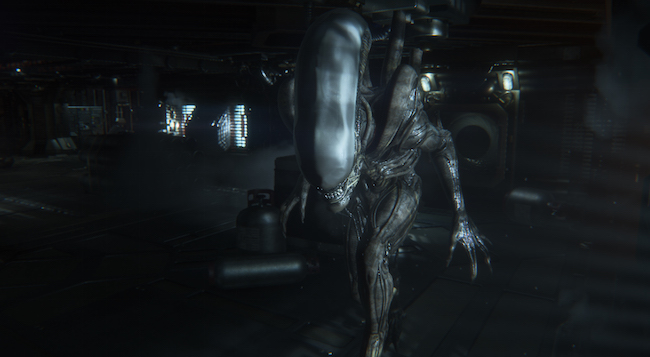
Alien: Isolation was considered to be the first dedicated “survival horror” crossover of the series, and from all accounts, it’s happened at the right time. Much of horror gaming in recent years has revolved around a heavily armed protagonist, resulting in a player who, instead of feeling weak and disempowered ends up being something of a character of high means and ability. For this reason, much of recent “survival horror” may be more accurately described as “horror-themed action”; however, there’s much more going on than simply returning to the dark, brooding roots of survival horror that Amnesia: The Dark Descent (2010, Frictional Games) did, though no doubt Alien: Isolation was strongly influenced by that direction of horror, in probably the most intelligent and articulate way yet.
Admittedly, my first impressions were not particularly favourable; adjusting to the pacing of Alien: Isolation took maybe two hours; however, the developers seem to have taken this into consideration, as players are gradually eased into the world of unfolding madness upon Sevastapol station; no human contact is made for a short while aboard the station, and while much of it is settling into the tech-noir ambience, it mainly allows for players to get a sense of direction and presence in the world, without forcibly being thrown into the deep end immediately.
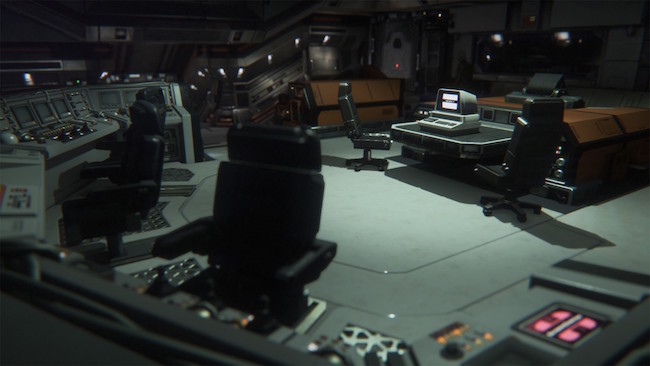
The most notable design decision was in removing the previous swarms of Xenomorphs waiting to be gunned down, and replacing them with a singular, invincible and incredibly lethal Xenomorph. There are also a handful of survivors roaming the station (some hostile, while others are friendly), as well as a number of “Working Joe” humanoid Synthetic cyborgs; narratively speaking, the “Working Joes” were an outdated series of obsolete Synthetics, with artificial-sounding voices, hairless ‘skin’ resembling rubber, glowing orange eyes and identical uniforms.
This is in stark contrast to many of the films and other media, which often depict the Synthetics as indistinguishable from their human counterparts. However, as a design choice, this enables players to accurately assess the nature and level of the threat in the immediate environment, as well as the relative ‘intelligence’ of the threat.
Intelligence is a contentious topic in any modern videogame, and I will admit, I was highly critical of the ‘humans’ I interacted with at first encountered some hostile survivors (I learned soon after from some online discussions that the most accurate ‘intelligent’ AI experience comes from playing on Hard, and I was playing on Medium; so if you’re yet to play through or are looking for an excuse to replay, then consider it!). While the AI, and some of the initial stealth mechanics felt a little clumsy and imprecise, I soon discovered, after my first Alien encounter, that the AI of all other encounters was scaled accordingly to the Alien’s sensitivity, which in some ways feels like the benchmark all others are calibrated from.

What’s interesting is the AI’s demonstrated capacity to ‘learn’ things about the player and player tactics; while human opponents generally don’t live long enough to demonstrate their learning, the synthetics (who, conveniently are very verbal about their readings from your actions), and of the course the Alien, who you may try and read by how doggedly it stalks your hiding places, the sounds it creates (from its various hisses, to how heavily or lightly it treads in its pursuit of victims). Also, an interesting, but cautious observation.
We’re treated to a wealth of semiotic codes in Alien: Isolation, and you’re going to need to pay attention to decode them. Of course, this may sound like a lot of work, but it’s actually an integral component of what makes the experience so enjoyable. No doubt, you’ll die A LOT, so you’d better get used to that, but the feeling of elation when you have survived another chapter is truly second to none, and in a way, your biggest reward is life itself.
I could be over-simplistic and say that this is essentially Amnesia set in space, or some kind of Amnesia/Dead Space hybrid, but there’s no way that could simply do justice to the intricately woven tapestry of extra-terrestrial body horror that the experience of Alien Isolation is; as previously mentioned, the primary design direction of Alien Isolation is a 180 spin on most other recent Alien titles in the series, redirecting the established which mainly focused on lightning fast action, gun fighting and swarms of Aliens towards a slow-burning, dread-filled crawl through the decaying space station.
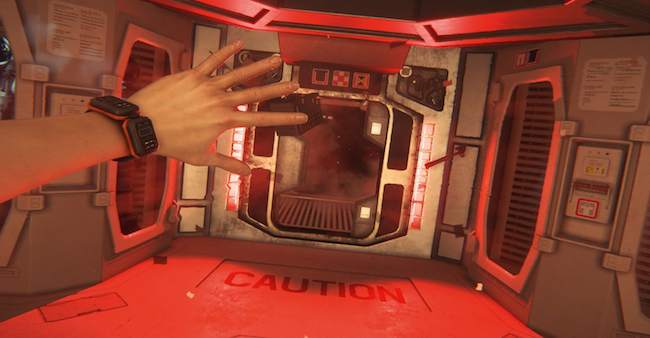
The team at The Creative Assembly did a fantastic job of implementing a variety of systems for the player to utilise, without providing them with too much of a sense of safety, advantage or security, and with clever little counterbalances to ensure players must think carefully about their next move; soon into the game, Amanda finds a Motion Tracker. That’s fantastic news for when it comes to knowing the rough position of, well, anything moving. But it also emits a distinctive ‘beep’ every time it does a sweep; that’s generally not too much of a problem, however it spells certain doom if you decide to whip out the Tracker while under the passive duress of a stalker, searching the room for you. The Tracker is also subject to some issues of non-reliability- it’s prone to some forms of magnetic interference, and can lose targets if they remain still for some time.
Additionally, the team at The Creative Assembly have implemented something of a crafting system; this fits in nicely with the narrative component of Amanda Ripley being an engineer for Weyland-Yutani (and let’s be honest, it’s one of the more convincing applications of an engineer protagonist in recent games); this means you’ll be finding salvageable electronic, chemical and scrap components throughout the game that, with the appropriate blueprints, Amanda can develop into various decoys, distractions, traps and, in some cases, defensive weaponry.

The great part of the crafting system is, for the most part, the game will not depend on you to do this; the applications of crafting items is entirely at the discretion of the player. Certainly, there are of the game where using certain items will make advancing easier or quicker; but this always comes with an offset- it will not only cost componentry to build these gadgets, but the use of them might end up attracting a far deadlier threat. It’s these judgements that the player must make as they progress through the ruins of Sevastopol. These judgements also affect the player’s overall detectability; this is very much core to the game’s design, as Alien Isolation is not meant to be a combative title; though confrontations may occur, they are not central to the experience of the game. The experience of Alien Isolation is centred on remaining undetected, difficult to track, and if possible, letting hostiles take care of each other with as little interference from the player as possible.
I had an interesting encounter through one of the midway chapters of the game where I found myself dealing with an increasingly persistent Alien, of whom I was only narrowly escaping, until I entered an area that had fewer than half a dozen hostile humans roaming around. After quietly bringing one of them down, and hiding out in a reasonably secluded corner, I heard the Alien, scuffling around in the overhead vents while the other adversarial AI humans continued to make some chatter and noise between themselves.
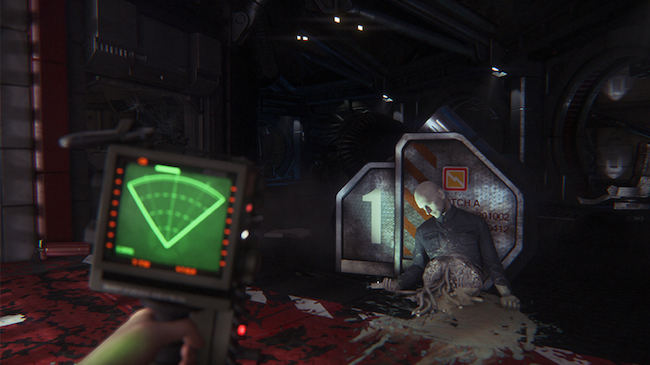
As the Alien was already moderately aware of my presence, this seemed to pique its interest sufficiently to cause it to climb down and investigate the area; as further audio queues suggested (such as humans yelling, gunshots, and the Aliens iconic pain ‘squeal’, followed by complete silence) that the Alien had gone after them instead of me, and, subsequently practically lost all interest in me. I’ve got to be cautious as I certainly can’t prove it, but it seemed like the Alien was appeased and somewhat satisfied from hunting the other humans in the areas; they weren’t only a distraction but it seemed satisfied that it had killed all the remaining humans around, unless some notable noises proved it otherwise
Pretty quickly, the player will learn that the large, open overhead vents are the Alien’s main way of getting in and out of the corridors the player must traverse; while overhead and out of sight, the Alien may still be tracked via the motion tracker, and in some cases if it hangs near a particular vent for some time it’s likely it’ll be entering the room at that point shortly, if it is given further reason to. However, a far more insidious application of these overhead vents may be observed (or experienced, should the unfortunate player stumble through at the wrong time), as an instant death trap- this happens when the player observes the semantically loaded image of the iconic Alien saliva dripping out of the vent, accompanied by a long, low hiss. Passing under these vents will result in instant death.
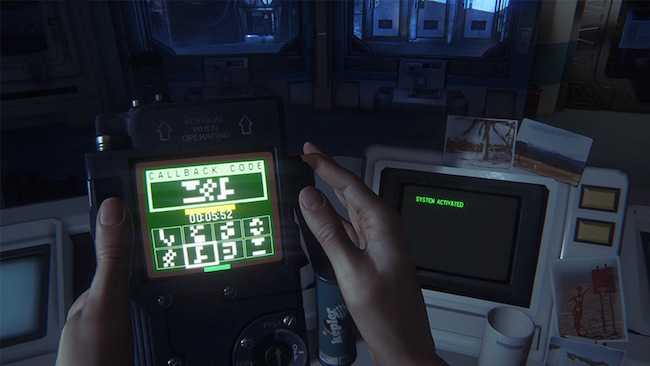
Aside from the well-tuned gameplay and design components of Alien Isolation, the most gratifying part of the overall presentation was how well the original vision of sci-fi tech noir was recreated; beyond simply any set or prop recreation (which for the record is spectacular), the overall technocentric theme of 1970’s sci-fi worked extraordinarily well- all the monitors and displays show pixelated, monochromatic text, the computer terminals are moulded with the same plastic/Bakelite veneer that contemporary technology also utilised, as well as the predominantly analogue feel of all the instruments used, such as the vaguely analogue motion tracker, the modulated beeps and buzzes of the ‘noisemaker’ gadget, and the mapping system, using basic monochromatic vector lines, all feels authentically retro-futuristic.
Even down to certain props and decorative items; throughout Sevastopol station, Amanda will creep past cardboard boxes full of audio cassettes, torn posters of beaches, ‘modern’ furniture (which still bears the 1970’s home décor look) and other iconic 1970’s paraphernalia, like the famous ‘drinking bird’ models. Everything around you is lovingly restored to its original lustre; it’s not simply retro-inspired, it’s retro-remade, and it makes the original terror so much more authentic because of it.
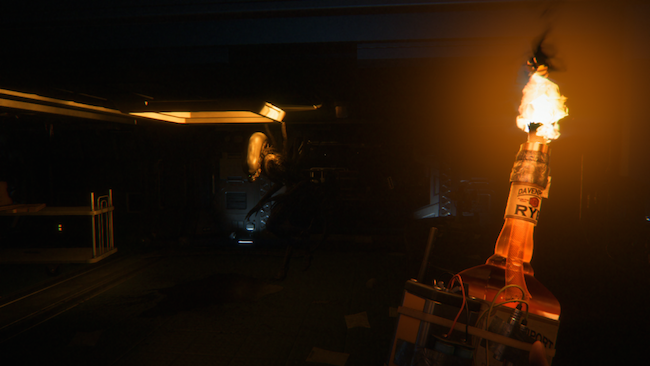
However, it’s not that Alien Isolation doesn’t make full use of modern conventions and technology; in fact, it’s remarkable just how the most cutting edge of development techniques and hardware have been utilised to create such a convincing façade of the tech-noir heyday of science fiction. Even down to the audio componentry of analogue beeps and buzzes from the electrical hardware, to the overall 1970’s architectural fundamentals of the station, the experience is as authentic as Ridley Scott’s 1979 iconic film, and for that it is most certainly worth the time of either: Fans of the original films, horror enthusiasts, or retro-future junkies.
In the past, games have been judged primarily by their graphics, which is a reasonable component to consider. However, if the independent development industry has taught us anything in recent times, it’s that hyper realistic graphics are not a pre-requisite for incredible interactive experiences. We are advocates for games being an expression of art, and as such, we consider art style, voice acting, sound design, and music to be just as important.
 Canonical narrative sure to please fans
Canonical narrative sure to please fans
 Authentic recreations of the source material
Authentic recreations of the source material
 Fantastic, innovative horror experience
Fantastic, innovative horror experience
 Game rewards caution over recklessness
Game rewards caution over recklessness
 Likely to appeal to the most demanding fans
Likely to appeal to the most demanding fans
 AI somewhat patchy in responsiveness
AI somewhat patchy in responsiveness
 Limited sense of environment
Limited sense of environment
 Can be tediously repetitive if you die a lot
Can be tediously repetitive if you die a lot
As my most anticipated title for 2014, I’ve got to say that Alien Isolation certainly did not disappoint. While a couple of elements feel slightly clumsy in execution (the AI feeling a bit inconsistent and unwieldy, as well as the moving mechanics feeling a bit loose in stealth situations), the overwhelming sense of dread, combined with the authentically tangible tech-noir setting make for a truly spectacular horror experience. It’s not often that licensed games get it right, but when they do, they truly bring the world they represent to life, and in turn inject new life into, and reinvigorate their source material. The Alien franchise has never gone down the road of slow-burning survival horror, which in a way seems ironic considering that this was the nature of the very film which spawned the timeless sci-fi saga, and this first foray has proved wildly successful. Who knows, maybe more developers will follow suite in the future?
Whether you consider yourself a die-hard Alien fan, have been awaiting a solid follow-up slow-burn horror after playing Amnesia: The Dark Descent, or are just fascinated by art imitating tech-noir, you’ll find something memorable and heart-stoppingly enjoyable as you steel your nerves to explore the decaying ruins of Sevastopol; just remember to look up and NEVER ignore the beeps.











